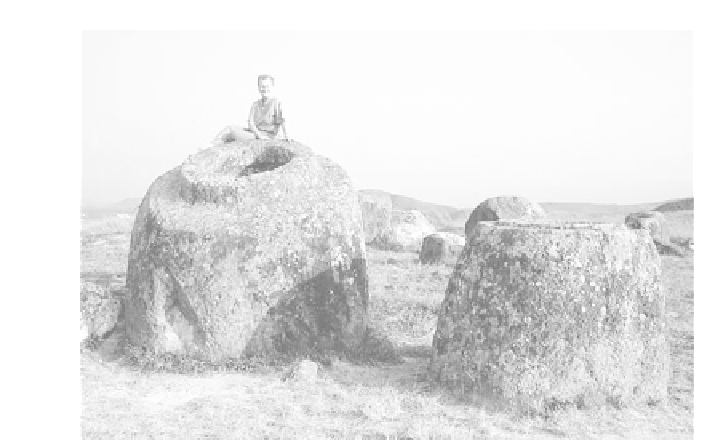Geography Reference
In-Depth Information
Figure 15-18
The Plain of Jars in Laos is an amazing place. I'm
sitting on one of the jars to give you an idea of the
scale of these objects. Their origin remains a
mystery .
Photograph courtesy of B. A. Weightman.
women cut and carry firewood. Women and children
carry water, tend gardens, look after small animals, and
are the main marketers for produce. Men look after and
market draft animals. In field work, men plow and har-
row the rice paddies, women plant seedlings, and both
sexes transplant, weed, and harvest the rice.
Lowland Lao are mostly Buddhist. Most villages
have a
wat,
which serves as a religious and social center.
The
wat
also serves as the village meeting house.
W ats
are
populated by two to six monks and a few novices, de-
pending on the size of the village.
Corn, cassava, and wild tubers supplement this diet.
Hunting and fishing are also important.
Gender role differentiation is much greater among
the hill people. Men clear and burn the swidden fields
and punch holes for seeds. Women follow , dropping
seeds in the holes and covering them with topsoil. Both
sexes weed, but this is regarded primarily as women' is
work. Harvesting is a joint activity . In the house women
cook, gather wood and water, and look after children.
Men weave baskets, repair farm tools, hunt for small
game, and are much more likely than women to manage
finances and engage in trade. Where villages have
schools, both boys and girls attend but girls have signifi-
cantly higher dropout rates.
Midland Society
Lao Theung
(Laotians of the mountain slopes) comprise
about a quarter of the population and consist of 37 differ-
ent ethnic groups. They speak languages of the Austro-
Asiatic family . Many are mutually incomprehensible.
Characterized as swidden farmers, the people of the
mountain slopes are semi-migratory , moving their vil-
lages on occasion as swidden plots are exhausted. Many
of these villagers were disrupted in the war, and many
have moved closer to the lowlands. T Traditionally, , how-
ever, lands were managed in a way to maintain sedentary
communities.
Lao Theung
villages are generally smaller than
Lao
Loum
villages. Some are divided into two segments with
a men' s common house in the middle. Villages of stilt
houses are situated near a stream to access water that
may be diverted via bamboo aqueducts.
Swidden rice economy is the basis for most commu-
nities. Both regular and glutinous rice are cultivated.
Upland Society
Lao Sung
(Laotians of the mountain tops) include six
ethnic groups. The Hmong are among the most numer-
ous. They also live in Vietnam and Thailand. The
Lao
Sung
are among the most recent migrants to Laos, having
initiated a series of moves from China in the nineteenth
century . All
Lao Sung
villages are located in the north.
Only the Hmong live as far south as Viangchan.
Lao Sung
typically reside above 3,280 feet (1,000 m)
on steep slopes and mountaintops. As swidden cultiva-
tors, most groups are semi-migratory . Y et some villages
have remained sedentary for over 100 years. Hmong
houses are built directly on the ground, with walls of ver-
tical wood planks and roofs of thatch or split bamboo.
Hmong swidden farming is based on white (non-
glutinous) rice, corn, and a variety of tubers, vegetables,

















Search WWH ::

Custom Search